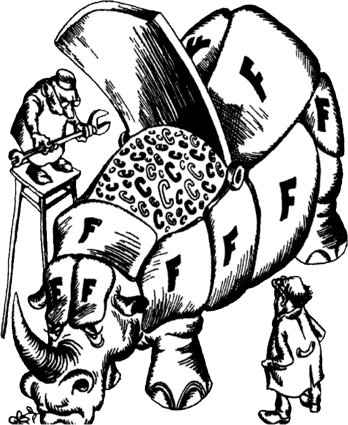107Stories About ChemistryINDEX |
94.
An Adamantine Heart and the Hide of a Rhinoceros
There is a class of compounds in organic chemistry called hydrocarbons. And that is just what they are, because their molecules contain hydrogen and carbon atoms, and nothing else. Their best known typical representatives are methane (constituting about 95 per cent of natural gas) and petroleum, from which various grades of petrol, lubricants, and many other valuable products are made. Take the simplest hydrocarbon, methane CH4. Now if we replace the hydrogen atoms in methane by oxygen atoms, what do we get? Carbon dioxide CO2. And if we replace them by sulphur atoms? A volatile poisonous liquid called carbon disulphide CS2. If we replace all the hydrogen atoms by chlorine atoms, we also get a well-known substance, carbon tetrachloride. But what if we take fluorine instead of chlorine? About three decades ago hardly anybody could answer this question intelligibly. But in our time the chemistry of fluorocarbon compounds is already an independent branch of chemistry. In physical properties fluorocarbons are almost complete analogues of hydrocarbons. But that is as far as their common properties go. In contrast to hydrocarbons, fluorocarbons are very unreactive substances. Besides, they are very resistant to heat. That is why they are sometimes called substances with �an adamantine heart and the hide of a rhinoceros.�  The chemical explanation for their stability compared to hydrocarbons (and other classes of organic compounds as well) is relatively simple. Fluorine atoms are much larger than hydrogen atoms and therefore render the carbon atoms they surround inaccessible to other reactive atoms. On the other hand, fluorine atoms transformed into ions are very reluctant to yield their elections and �dislike� to react with any other atoms. Fluorine, as we know, is the most active nonmetal, and there is practically no other nonmetal which can oxidize its ion (i.e., remove an electron from it). Again, the carbon-carbon bond is itself very stable (remember diamond). Owing to their inertness fluorocarbons have found a wide range of applications. For instance, fluorocarbon resins called Teflon can withstand heating to 300�C and are indifferent to sulphuric, nitric, hydrochloric and other acids. They resist boiling alkalis and are insoluble in all known organic and inorganic solvents. Not for nothing are fluoroplastics sometimes called �organic platinum�: they are splendid materials for making chemical laboratory ware, various industrial chemical equipment, and pipes for a great variety of purposes. Believe us, very many things in this world would be made of platinum, were it not so expensive, but fluoroplastics are comparatively cheap. Fluoroplastics are the most slippery substances in the world. A fluoroplastic film thrown on a table will literally �flow off� it on to the floor. Bearings made of fluoroplastics require practically no lubrication. Finally, fluoroplastics are excellent dielectrics and very heat-resistant ones too. Fluoroplastic insulation can withstand heating to 400�C, which is above the melting point of lead! Such are fluoroplastics, which are among the most remarkable man-made materials. Liquid fluorocarbons are noncombustible and freeze at very low temperatures. These compounds are not attacked by fungi or insects, and are very resistant to corrosion. |





